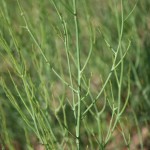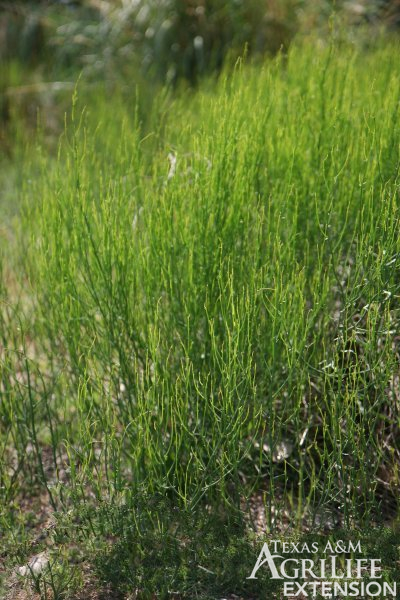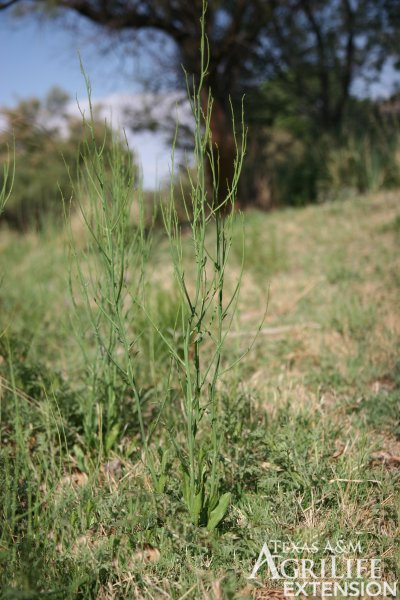Spiny Aster, Wolfweed, Mexican Devil-weed, Spiny Chloracantha
Chloracantha spinosa (Benth.) G. L. Nesom
Asteraceae (Sunflower Family)
Description
Spiny Aster is a native, warm-season perennial that can grow from 1 to 9 ft or 0.3 to 2.7 m tall. It is also called Devilweed Aster. It colonizes areas via underground rhizomes and can infest a large area. The plant is characterized by green stems with stripes, and occasional spines on the stems. Branches are lateral, ascending, and wand-like. Its leaves are attached directly to the stem without any supporting stalk and have smooth leaf margins. The basal leaves are long and narrow but may be shaped like a spatula and reach up to 2 inches long. Its upper leaves are small and scale-like. Leaves are present for a brief period in the spring when the young stems are succulent. The leaves drop off after 2 to 3 weeks, and the stems begin conducting photosynthesis. It has solitary flowers that have white petals and small, yellow corollas in the center disk. Its flowers are loosely branched and mature from the bottom up. There are typically 20 to 33 ray flowers and 20 to 70 disc flowers. The plant flowers from May to December. It has an achene fruit that is white to tan in color. The fruit is smooth, hairless, about ¼ inch or 6.4 mm long, cylinder-shaped, and has 5 veins. The fruit is topped with 30 to 60 white to tan sepals of short bristles in a series of 1 to 2, with shorter outer bristles. Because only some mature stems survive through the winter and continue developing the following season, mature stands of Spiny Aster often have an abundance of dead stems. A mature community may support more than 100 stems per square meter. Spiny Aster's forage value is poor for livestock and wildlife.Habitat
Spiny Aster can grow abundantly along lowland streams, roadsides, weedy slopes, stream banks, ditches, depressions, bottomlands, cultivated fields (mainly cotton and alfalfa), saline flats, and riverbanks. It invades sites that have a high potential for forage production and upland sites where the soils have a high clay content and a high water-holding capacity. Its plant communities include riparian and disturbed sites. Elevation ranges from 1,000 to 4,200 ft or 305 to 1,280 m. Its native range is Central and South United States to Central America, and it commonly grows in subtropical biomes.Images
Plant Characteristics
Flower Color: White
Seed Type: Achene
Duration: Perennial
Stem Texture: Prickly, Spiny, or Thorny
Growth Habit: Forbs/Broadleaf
Leaf Shape
 : Simple with Pinnate or Parallel Venation
: Simple with Pinnate or Parallel Venation
Season: Warm
Distribution
 : 02 - Gulf Prairies and Marshes, 03 - Post Oak Savannah, 04 - Blackland Prairies, 05 - Cross Timbers and Prairies, 06 - South Texas Plains, 07 - Edwards Plateau, 08 - Rolling Plains, 10 - Trans-Pecos
: 02 - Gulf Prairies and Marshes, 03 - Post Oak Savannah, 04 - Blackland Prairies, 05 - Cross Timbers and Prairies, 06 - South Texas Plains, 07 - Edwards Plateau, 08 - Rolling Plains, 10 - Trans-Pecos
Distributions
Distribution refers to the ecological region in Texas that a plant has been found. You can also view a clickable map.
Book: Brush and Weeds of Texas Rangelands (B-6208)
Collection: Brush and Weeds








